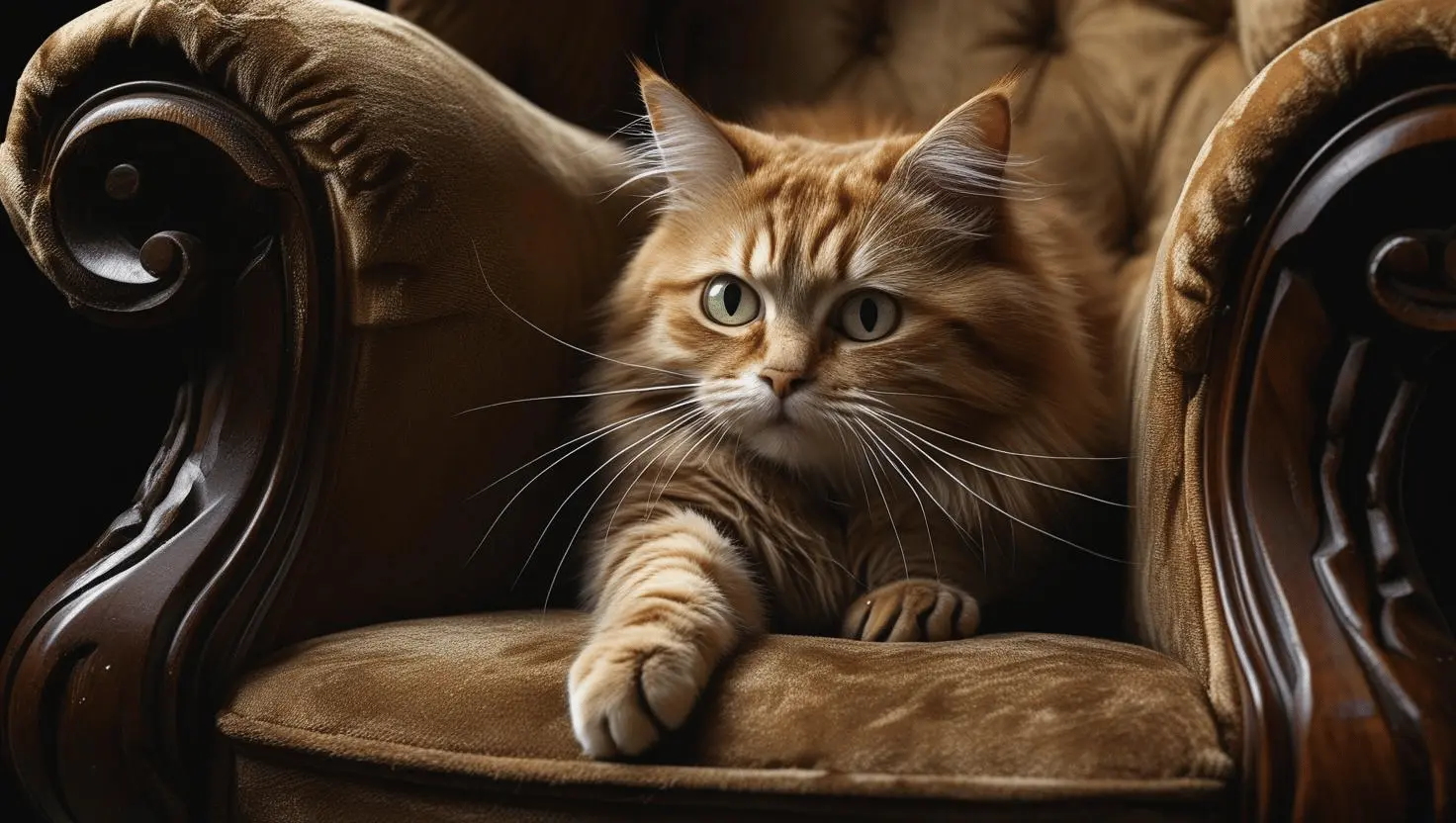Cats scratch furniture because it’s part of their natural instincts. They do it to mark territory with scent glands, keep their claws healthy, stretch and exercise their muscles, and relieve stress or boredom.
Why Do Cats Scratch Furniture? 🐾
Cats scratch furniture because it’s part of their natural instinct. They do it to mark territory, keep their claws healthy, stretch their muscles, and relieve stress. It’s not misbehaviour — it’s simply how cats express themselves and care for their bodies.
Claw Maintenance ✂️
Scratching helps cats shed dead outer claw layers, keeping their nails sharp, healthy, and functional. Without suitable outlets like scratching posts, furniture often becomes their go-to nail care station.
Stress Relief and Boredom 😺
- Stressed by environmental changes
- Feeling anxious due to new pets or strangers
- Simply bored and craving stimulation
1. Marking Their Territory 🏠
Cats naturally scratch sofas, chairs, beds, and other household surfaces to mark their territory. Their paws contain scent glands that leave behind a chemical signal while scratching creates visible marks.
This behavior is even stronger in multi-pet households, where cats feel the need to establish boundaries against other pets.
How to Fix It:
- Provide multiple scratching posts: Place them in different rooms, especially near the furniture they target most.
- Choose the right material: Cats prefer sisal rope, cardboard, or wood, so pick posts made from these textures.
- Use scent attractants: Sprinkle catnip or use pheromone sprays on scratching posts to make them irresistible.
Related Posts
- Why Do Cats Meow at Night? 4 Fascinating Explanations
- Why Do Cats Knead Blankets and Pillows?
- Why Do Cats Sit on Laptops and Books?
- Why Does My Cat Lick Me Then Bite Me?
- Why Does My Cat Rub Its Face Against Me?
2. Boredom and Lack of Playtime 🎾
Sometimes, your cat scratches the furniture simply because they’re bored or under-stimulated. Cats are naturally active, curious hunters, and when they don’t get enough mental or physical engagement, they often turn to scratching as a way to release pent-up energy or frustration.
Solutions:
- Dedicate at least 15 minutes daily to interactive play: Use toys that mimic prey, like feather wands, teaser sticks, or moving mice.
- Rotate toys regularly: Changing toys keeps your cat mentally stimulated and prevents boredom.
- Try puzzle feeders or treat-dispensing toys: These encourage natural hunting behaviors while keeping their mind sharp.
- Create a stimulating environment: Set up window perches or cat trees so they can watch birds, squirrels, and other outdoor activities.
3. Stress and Anxiety Triggers 😿

Sometimes, the answer to why your cat scratches the furniture lies in stress or anxiety. Cats are sensitive creatures, and even small changes in their surroundings can make them feel insecure or threatened.
- Environmental changes — moving homes, rearranging furniture, or redecorating
- New pets or visitors — unfamiliar scents and sounds can make them feel uneasy
- Loud noises — fireworks, traffic, or construction sounds
- Loss of routine — cats thrive on predictability, so sudden changes can make them restless
When cats feel stressed, scratching becomes a way to self-soothe. It helps them release tension and mark their safe zones through scent.
Solutions:
- Keep their environment predictable: Maintain a consistent routine for feeding, playtime, and sleep.
- Create safe spaces: Set up quiet hiding spots where your cat can retreat when feeling overwhelmed.
- Use pheromone diffusers or sprays: Products like Feliway can help calm anxious cats by mimicking natural facial pheromones.
4. Lack of Suitable Scratching Surfaces 🪵
One of the biggest reasons your cat scratches the furniture is simply because they don’t have better options. Scratching is a natural instinct, and if you don’t provide suitable alternatives, your sofa, chairs, or bed quickly become their favorite targets.
Cats have personal preferences when it comes to scratching — some love vertical surfaces like posts, while others prefer horizontal scratchers like mats or pads.
Solutions:
- Invest in sturdy scratching posts: Choose posts made from sisal rope, sisal fabric, or durable cardboard — cats love these textures.
- Offer a variety of scratching options: Try both vertical posts and horizontal scratchers to match your cat’s preference.
- Place scratchers strategically: Position them near furniture your cat already scratches, making it easier to redirect their behaviour.
5. Attention-Seeking Behaviour 🐱

Sometimes, your cat scratches the furniture not because they need to — but because they know it gets your attention. Cats are smart and quickly learn that scratching the sofa makes you react instantly — whether you scold, shout, or chase them away.
For some cats, negative attention is still attention. If they’re feeling ignored, bored, or lonely, scratching becomes a way to communicate and make sure you notice them.
- Avoid scolding or shouting: Negative reactions can reinforce the behavior and make your cat scratch even more.
- Reward positive scratching: Praise and give treats when your cat uses the scratching post instead of the furniture.
- Stay consistent: Everyone in the household should follow the same approach to avoid confusing your cat.
How to Stop Cats from Scratching Furniture 🛋️🐾
If you’ve been asking yourself, “Why does my cat scratch the furniture?”, knowing why is just half the battle — the next step is redirecting the behavior. Since scratching is instinctive, the goal isn’t to stop it completely but to guide your cat toward acceptable alternatives.
1. Use Deterrent Sprays 🧴
- Choose non-toxic, vet-approved sprays.
- Pair sprays with attractive scratching posts nearby to redirect the habit effectively.
2. Protect Furniture with Guards and Covers 🪑
- Use scratch-proof guards, slipcovers, or adhesive sheets to shield vulnerable spots.
- Always place a scratching alternative close by to give them a better option.
3. Clip Claws Regularly ✂️
- Start trimming gradually if your cat isn’t used to it — reward them after each session.
- If trimming feels challenging, a vet or groomer can help.
4. Use Positive Reinforcement 🐾💛
- Use clicker training to reinforce desired behaviors.
- Be consistent — everyone in the household should follow the same rules.
When to Consult a Vet or Behaviourist 🩺🐱

While occasional scratching is normal feline behavior, if your cat’s scratching becomes excessive, destructive, or sudden, it might signal an underlying problem rather than just instinct.
Here are a few possible causes:
- Anxiety or stress disorders: Major lifestyle changes, frequent visitors, or new pets can trigger compulsive scratching.
- Underlying pain or discomfort: Cats may scratch more if they’re experiencing joint pain, skin irritation, or allergies.
When to Seek Professional Help:
- If your cat damages furniture despite multiple solutions
- If scratching is paired with other symptoms like hiding, loss of appetite, or aggression
A veterinarian can rule out medical issues, while a feline behaviourist can help create a customized behaviour modification plan to redirect scratching in a healthy, stress-free way.
Common Questions
Do cats scratch furniture to get attention?
Yes, some cats scratch because they’ve learned it gets a reaction. Instead of scolding, ignore unwanted scratching and reward positive behavior when they use approved scratching areas.
When should I see a vet about my cat’s scratching?
If your cat’s scratching is sudden, excessive, or destructive, or comes with other signs like hair loss, aggression, or hiding, consult a vet. It could indicate stress, pain, allergies, or compulsive behavior.
Are there sprays to keep cats from scratching furniture?
Yes, cat-safe deterrent sprays make furniture less appealing by using scents cats dislike. Use them on commonly scratched areas and pair them with attractive scratching posts placed nearby.


2 thoughts on “Why Does My Cat Scratch the Furniture? 5 Fixable Reasons”